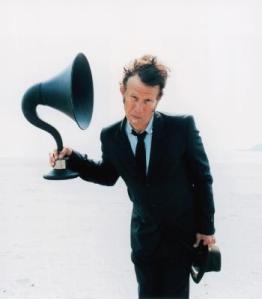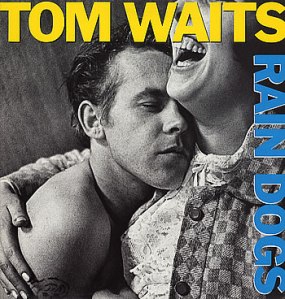I’ve mentioned before my parents being armed with a fairly sizable collection of records and musical knowledge. Often, my parents would expose me to important artifacts from before my time that they felt were essential for me to be exposed to. I remember on certain weekend nights in 8th and 9th grade when I was bummed that plans with friends had fallen through, my dad would play me some of his favorite vinyl tracks from the late 1970s. Some of these failed to stick, but one in particular stands out in my memory: “Whistlin’ Past the Graveyard” by Tom Waits from 1976’s Blue Valentine.

After years of performing, Tom Waits' hearing has gone out on him. He just can't figure out how to work his new listening device.
It’s not the Tom Waits that many people of my generation are familiar with. This is the jazzy Tom Waits, sounding musically like pre-Born to Run Bruce Springsteen but with a maniacal growl that he imbued with unexpected vocal abilities. He throws around badass one-liners like, “I’m going to tear me off a rainbow, and wear it for a tie / I’ve never told the truth, so I can never tell a lie,” but balances those with surprisingly vulnerable couplets like, “When I get a little lonesome, a tear falls from my cheek / There’s going to be an ocean in the middle of the week” (which I guess is as badass a way of singing about your pain as there could be).
That, along with the groovy blues of 1980’s “Heartattack and Vine” (check out this black and white live version and listen for those lyrics: “I bet she’s still a virgin, but it’s only 25 to 9;” and “Don’t you know there ain’t no devil? There’s only God when he’s drunk”), was what I knew of Mr. Waits, until my younger brother came along. I’m not sure how, but he got into my parents’ CD of Waits’ 1992 album Bone Machine, and he took me right along with him. From the leadoff track, “Earth Died Screaming,” it’s clear that this is a very different Tom Waits. With percussion that can only be described as sounding like bones, Waits alternates between a near-spoken rasp and deathly howl. His lyrics are more concerned with creating a distinct atmosphere than producing any particular statement. The rest of the album continues to resonate with such tracks as the slow and depressing lament “Dirt in the Ground” and the warped gospel of “Jesus Gonna Be Here” (the album version is much starker than this live one from 2000).

Contrary to popular belief, this is not Tom Waits on the cover of his 1985 classic. It's some German guy named Rose. True story.
It wasn’t until later that I discovered the missing pieces: 1983’s Swordfishtrombones and 1985’s Rain Dogs. Written with his new wife and now permanent writing partner, Kathleen Brennan, these are widely regarded as masterpieces. Both regularly make critics’ lists of the top albums of the 1980s, and surely stand alone among even those other classics as something not of the 80s. There are no synthesizers, no turntable scratches, no ringing guitars. Instead, there are meandering leads, pipes as percussion, tubas, accordions, spoken word poetry, and Waits reveling in the growlness of his growl. He’s not trying to skillfully sing like with his 70s material; he’s letting his voice do what only his voice can. Check out the first song of Swordfishtrombones, “Underground.” It’s unlike anything else ever, let alone in 1983. He goes on to explore blues, torch songs and a variety of other genres with classics like “16 Shells from a Thirty-Ought Six” and the title track.
Yet even that does little to prepare you for the mastery of Rain Dogs. It kicks off with a chicken squawk on “Singapore” and doesn’t let up with the weirdness, absurd lyrics and original sounds. The exotic shuffle of “Jockey Full of Bourbon,” the bizarre dancehall of “Tango Till They’re Sore,” the stomp of “Big Black Maria” with one Keith Richards on guitar, the sparse bluegrass of “Gun Street Girl,” the schmaltzy pop of “Downtown Train,” and closing with the hobo gospel of “Anywhere I Lay My Head.” It’s a tour de force, full of some of the greatest songs ever written, sounding as fresh and exciting today as ever.

After this fall, Waits decided to give up his burgeoning gymnastics career and focus instead on music.
And yet, this is nowhere to stop with a Tom Waits profile. More can be said of his early years – the ballads! (“Ol’ 55” and “Martha” were written when he was just 24; “The Piano Has Been Drinking,” “Tom Traubert’s Blues,” – here live on the Old Grey Whistle Test in 1977 – the list goes on) the bustlers! (“Eggs and Sausages” fucking blows my mind and “Wrong Side of the Road” isn’t half bad either) More can be said of his later years – like the whole of 1999’s Mule Variations, which I have been quoting all week. It’s got some of the best lyrics top to bottom (that’s “Big in Japan” to “Come on Up to the House“) that I’ve ever heard (and I recognize that those are both live versions so the lyrics aren’t as discernible; whatever).
I think the most incredible testament of his influence and reach can be found in the covers of his songs. He’s gotten a treatment from the Eagles (“Ol ’55“), Rod Stewart (“Downtown Train“), Bruce Springsteen (“Jersey Girl“), Bob Seger (“New Coat of Paint“), the Ramones (“I Don’t Wanna Grow Up“), Elvis Costello (“Innocent When You Dream”), the Blind Boys of Alabama (“Way Down in the Hole” – aka the theme song to The Wire), Tim Buckley (“Martha“), Meat Loaf (also “Martha“) Dion (“Heart of Saturday Night“), the Violent Femmes (“Step Right Up“), and an impressive slew of female artists: Sarah McLachlan (“Ol ’55“), Bette Midler (“Shiver Me Timbers“), Neko Case (“Christmas Card From a Hooker in Minneapolis“), Marianne Faithfull (“Strange Weather“), Lucinda Williams (“Hang Down Your Head“), former Waits flame Rickie Lee Jones (“Rainbow Sleeves“), Norah Jones (“Long Way Home“), Diana Krall (“The Heart of Saturday Night“), Tori Amos (“Time“), and Cat Power (“Yesterday is Here“).
Goddamn. That’s a lot of artists. Tom Waits’ reach will continue to influence songwriters, and it was hard to put him only at number 5 on my list here. I think, though, that the top 4 have massively changed the actual form of music itself, with very tangible lineage to prove that music today would not be what it is without them. Clearly, the same can be said for Tom Waits, but his influence is subtler, slower, like his songs, winding its way into and out of our collective musical history. He was only the second-best songwriter of his time (second to Bob Dylan). For that, the RnRHoF voters should do what’s right this year and vote him into the Hall of Fame – only 12 years after he was first eligible.
Posted by sam can cook on November 12, 2010 at 8:47 pm
Not gonna lie, I’d always been intimidated by Waits’ catalogue and didn’t know where to begin. Same with that experimental music you and David and Tom used to talk about sophomore year when we’d go to Tom and Chase’s room to play beer die. Ah, nostalgia.
Posted by peter on November 15, 2010 at 8:09 pm
He had one of the great word play lines during a Tonight show interview…when asked if he like to imbibe he growled…”I’d rather have a bottle in front of me than a frontal lobotomy.”
Posted by Sara on November 17, 2010 at 7:46 pm
that was him? my mom loves that line!